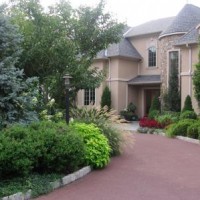2013 Best Design Winner, Chris Cipriano explains how to maintain concrete paver driveways, patios and walkways on your property – Bergen County, Northern NJ
If you have a concrete paver walkway, driveway or patio there are some essential maintenance tips you should know about. It is important to keep up on regular maintenance of these areas to make sure to maintain the value and beauty of the pavers.
Whenever you see a stain, the best time to clean it is right away. The longer the stain sits on the concrete paver the deeper it will penetrate and becoming harder to remove. Annual power washing helps maintain the beauty of the pavers, especially near large wooded areas where tree sap can build up on the surface of the pavers. Once you are done power washing you may have to reinstall sand into the joints. If the pavers were finished with polymeric sand then this shouldn’t be necessary. Polymeric sand has a blend of polymer additives which bind together when moistened. If you have sand in the joints then now is the time to refinish the area with polymeric sand.
Pour the polymeric sand on the concrete pavers and then gently sweep it into all of the joints between the pavers. When you have a sufficient amount of sand the final step is to mist down the area. Don’t spray water with too much force or you will remove all of the polymeric sand you just applied. Instead lightly mist the whole paver area to allow the sand to settle and strengthen forming a strong structure between the pavers. The polymeric sand will harden and keep weeds from growing in the pavers.
Settling is also very common with pavers and once pavers begin to settle puddles accumulate and the area becomes stained where the dirt gathers. Repairing these areas is import in maintaining the beauty of the pavers. If the settling is less then an inch the pavers in the settled area can simply be taken out and sand can be installed to the original sub base elevation and reinstall the pavers. If the settling is more than an inch then quarry process is compacted beneath the sand first.
Another common maintenance issue with pavers is separations in high traffic areas, most often effecting driveway areas that require sharp turns. When separation occurs in this field of pavers, the first step is to determine where the closest border is because that’s where the pavers get reinstalled to. The pavers get removed and relayed all the way to the border, then a new cut is made so the soldier course can get reinstalled. You will need new pavers for the cut in, so if you don’t have any surplus from the original installation you can try to match the pavers from your local supply yard. Install the new pavers into the field blended with the old pavers to disguise any differences.
Another issue you may come across is efflorescence. Efflorescence is a white haze that may appear on the surface of the concrete pavers sometime after installation due to a natural chemical reaction in the cement. There are three ways to remove efflorescence; the first is with a simple scrubbing with a bristle brush or wire brushing. The second is sandblasting, usually reserved for large areas but caution must be used to not damage or pit the surface. The last is a chemical wash using diluted muriatic acid, rinse thoroughly and be sure to control runoff.
If you keep up on the maintenance of your paver areas you will receive much more enjoyment from your beautiful walkway, patio or driveway for years to come. Proper maintenance will also help with a better return on investment if you ever decide to sell your home.
For more information on paver patio design, installation or maintenance please contact our office, 201-785-0800








